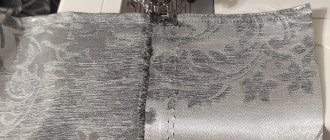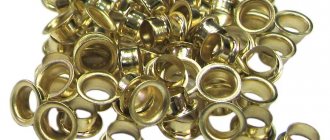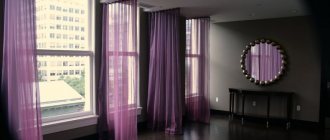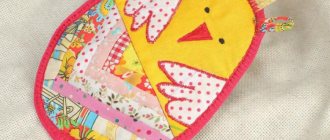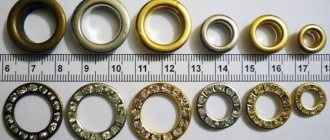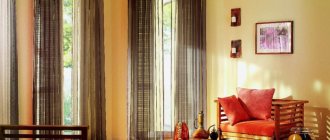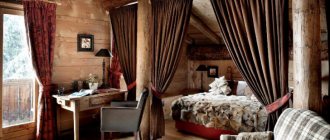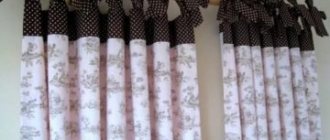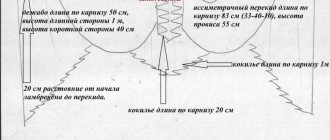Sewing curtains yourself is easy, because there are many master classes on this topic. How to sew curtains with the correct pattern, this issue has its own characteristics.
General sewing rules
How to sew curtains? So, this is a large piece of material that anyone can sew. Neat curtains can be sewn by following these rules.
- Prepare for sewing. Choose the material that you like best, consider the density.
- Calculate the fabric. Curtains are divided into: tulles and drapes. Calculate the size using the height of the window or wall and the length of the cornice. Consider the hems of the bottom and top, as well as the gathering factor.
- Take care of further care. Take any piece of fabric before you buy the entire fabric and try washing it with the product you will use in the future, in order to protect yourself from deformation of the seams. Another way to find out about care is to ask a sales consultant.
- Cut before sewing. Before working with the main fabric, it is better to do the first cutting and sewing option on any other, so you will take into account all your mistakes. Determine the front side. The curtains will be placed vertically on the window, so a precise, even seam will be visible. Don't forget about the pattern; if there is one, it should be symmetrical with the other curtain.
- Create a pattern according to your measurements. A pattern of length, width and height is created on graph paper or tracing paper.
- Open the fabric. Trace the pattern with chalk or a felt-tip pen and cut along the contour.
- Process the edges using a sewing machine , remembering accuracy and safety precautions.
What materials are needed to sew curtains?
Specialized stores offer a huge selection of materials that are suitable for the implementation of any idea. Fabrics and textiles differ in density and texture, colors and prints, and complexity of processing, so after choosing an idea, the best material for its implementation is selected.
Dense and heavy fabrics look good when gathered; they are easy to form into folds and multi-layered curtains. Most often these are curtain textiles, thick silk and brocade, iridescent velvet and patterned tapestry; satin and taffeta are used for lining.
Light and airy fabrics such as organza or muslin are chosen for curtains and help add variety to multi-layer curtains. They are quite difficult to work with, but they allow maximum light to pass through, so such products are combined with curtains to create a harmonious composition when decorating window openings.
For the kitchen, children's room, and country house, you can choose materials such as cotton and satin, silk and natural linen. They are distinguished by wear resistance and a huge variety of thematic decor, images and ornaments, and these materials are the easiest to work with even for a novice craftsman.
Required tools and materials
Includes both auxiliary and basic materials. To sew tulle or curtains use:
- A sewing machine is equipment that can be used to sew products and make even and clean seams.
- Presser feet for a sewing machine , they come in different types; they are needed for curtains: for finishing edges and for main seams.
- Pins - safety pins or tailor's pins - are needed for basting and hemming the material.
- Sharp scissors , use tailor's scissors, but if you don't have them at hand, use sharp ones;
- The iron is the main equipment, as it is needed for the stage when working with the product. First of all, they are processed, ironed and steamed, and at the end of the work, they are also ironed well.
- Needles and threads for basting and sewing seams , it is better to baste by hand and then sew on a machine.
- Graph paper or tracing paper.
- Pen, felt-tip pen, pencil or chalk.
- A flap will help you choose fabric and needles for your sewing machine.
- Curtain tape , it is needed to attach the product to the cornice, otherwise called braid.
Bedroom and living room windows with curtains
To create a successful pattern for curtains for the bedroom, it is better to look through the standard options and, if necessary, modify them a little to your liking. The main thing is that the window is well closed during rest hours and lets in a sufficient amount of light the rest of the time. The bedroom is a place of privacy, so the curtains should be the color that is most conducive to relaxation.
Curtain patterns in the hall most often have a more complex cut. However, by carefully understanding all the subtleties and nuances, you can create a real masterpiece - the pride of the owner of the house.
Choosing fabric for sewing
How to sew curtains for the kitchen, living room, bedroom and other rooms? So, it’s worth deciding what kind of curtains you want to make for your interior. If it is tulle, then the fabric can be different:
- Organza. The material it is made of is polyester or viscose. The advantages are that it allows sunlight to pass through, dries quickly and does not wrinkle. The downside is low breathability.
- Veil. Material: natural fibers. Pros - breathable material, that is, high air permeability, does not electrify, does not attract dust. The downside is that it requires delicate care, since natural fibers have the ability to deform when washed.
- Net. The classic look of tulle, made of synthetic threads. It allows air to pass through well and matches with curtains of different colors and patterns. The downside is that it is highly electrified, which requires quite a bit of maintenance.
- Muslin. Cotton material, natural. Pros: pleasant to the touch, has many shades. Cons: It wrinkles quickly and requires constant ironing.
- Chiffon. Material: cotton or silk. Pros: attractive appearance, good air permeability. The downside is that chiffon is difficult to work with for beginners and is expensive.
For curtains you need others, here the density is greater, they are not light like cotton fabrics, since they protect from the sun.
Therefore, the following options are recommended:
- Linen. It will last a long time, is resistant to ultraviolet radiation, dirt and stains are easily washed off, and is quite durable. Disadvantages of linen - price, deformation after washing, because... requires special care.
- Matting. The material is coarse and made in a checkerboard weave. The advantages of matting are that it does not require maintenance, has an impressive appearance and is wear-resistant. Disadvantages - in the filing, in the sprinkling of the edges, there are puffs left.
- Gabardine. Material: wool, cotton, silk. Gabardine is dense due to the weaving of the threads diagonally. Pros: breathable, waterproof and easy to care for. Cons - crumbles.
- Velvet. Chic, luxurious fabric is used in a classic interior. Pros - does not allow sunlight to pass through, does not fade, provides good sound insulation. Disadvantages - they are harmonious in large rooms, the cornice on which the curtains are hung must be well attached to the wall.
- Jacquard fabrics. Made with drawings or ornaments. Stylish, but unfortunately not suitable for all interiors. They are easy to care for and do not fade in the sun.
What is important to consider
The complexity of the execution depends on the chosen model. In addition, be sure to study the attached instructions, and all actions are carried out strictly according to them. Ultimately, it will become clear that the task was within your capabilities, despite the apparent difficulties.
First of all, decide on your wishes. Which room are the curtains intended for, what style is present in the interior and what color palette will be most suitable for the colors and shades already present. In addition, you need to know exactly the functions of the curtains for which all this work is being done.
Calculation of fabric cuts for curtains and tulle
So, first of all, you need to know how much material you will need, for example, for a do-it-yourself Roman blind. The length of the cornice is measured, and the gathering factor is taken into account, usually it is 2. Using these values, the fabric consumption for the tulle is calculated. Multiply the length of the cornice by the assembly factor.
The consumption for curtains is calculated with folding elements according to the dimensions of the curtain height, bottom hem and top hem.
Roman curtains
To sew a Roman blind, the pattern will not be too complicated. Quite the opposite. This is one of the simplest options. Initially, measurements are taken in such a way as to completely close the opening. The fabric chosen is quite dense and rough. You need a cornice for this type of curtain and threads to match the fabric.
Patterning curtains for beginners is quite simple:
- A rectangle is drawn on the material in accordance with the measurements taken. It's quite easy to work with non-slip fabric. Five cm should be added to the drawing on the sides. Twelve cm is an increase in the lower part;
- The folds are ironed and stitches are made along them;
- The curtain is placed on a special cornice structure.
Uncover
To cut correctly, you will need a grain thread: it makes cutting easier, since there will be no deformation of the product, and you will not get asymmetrical curtains for the kitchen, living room or bedroom.
- draw a pattern by elements;
- small details are indicated;
- trace the constructed pattern from the wrong side, not forgetting about seam allowances;
- To prevent the material from shifting while tracing the pattern, it is better to pin the paper to the fabric;
- cut with sharp scissors.
Sewing a lambrequin: from creating a pattern to forming the finished product
Materials and tools for sewing:
- base material;
- lining fabric;
- nuts and screws.
Decorating with tassels
First you need to create a pattern; you can find many options on the needlework website. Once the style of the curtains is known, the fabric is purchased and sewing begins.
To begin, attach the material 8 cm above the window, the distance on the side should be no more than 7 cm. This type of lambrequin can be sewn in length up to the window sill.
It is important to make the calculations correctly. For a 45 cm cornice you need 70 centimeters of material.
Trim the backing material that is used to provide rigidity. It will hold the wrinkles. Connect and pin all layers and make a seam, leaving 25 centimeters on top unfinished. Turn the product inside out and close the holes. Attach the curtain rod to the curtain and make the required number of folds, tightening them with laces.
Draping a veil
How to fold fabric correctly
There are step-by-step instructions for performing a hem:
- Once you iron the material you are going to sew, measure from the top edge the same amount of cm as the width of the curtain tape. Bend the measured cm inward and go over it with an iron, thereby fixing the bend with steam.
- After either using pins or basting with a thread and needle, secure the hem.
- Use your sewing machine and make sure the sewing machine foot is positioned along the edge of the folded fabric.
Rest and sleep area
The color of the curtains will go well with furniture or a chandelier, thereby emphasizing the style of the room. In the relaxation room, bed colors should prevail; a set of curtains for the bedroom should not be bright.
This room differs from others in its calm atmosphere and tenderness. Where after an active day you can relax and unwind.
How to make a pattern yourself
How to make patterns for kitchen curtains for sewing yourself using a pencil, ruler and paper? A pattern is an exact drawing with dimensions for a product. You have all the calculations, lengths and widths of the canvas, assembly factor and allowances. Taking into account all the details, we build a pattern on paper, noting the calculations for length and width.
Using these patterns you can sew Roman or Imperial curtains and even decide on sewing curtains and bedspreads.
Types of curtains and their design features
Curtains used in the interior can be of different types and sizes, differ in design, length and type of material used. For a country house or kitchen, you can sew small and simple curtains, but for a living room decorated in a certain style, it’s easy to choose multi-layered designs.
At the preparation stage, interesting ideas are selected, a combination of colors and shades, the texture of the material for sewing and, of course, the types of finished products:
- English, classic curtains in a restrained style;
- curtains with ties with simple pipe fastening;
- Roman blinds with clips and special fasteners;
- lambrequins covering part of the window and complemented with tulle.
When choosing the type of curtains, you need to pay attention to the length of the product, which can be different and must be combined with the style of the room:
- long to the windowsill;
- height below the window sill;
- descending to the floor.
At the stage of preparing the sketch, you should think over the design of the curtains and consider how many layers of material there will be in order to make the correct calculations. Curtains for windows can be straight or gathered in large pleats, gathered along the entire length, opening or assembled using fasteners.
It is quite difficult to achieve the ideal appearance of finished products without some practice, but if the instructions are correctly reproduced, sewn curtains will outperform purchased models.
Difficulties in cutting yourself
The self-cutting master class is conducted without basic knowledge, since there are not many difficulties.
- When placing the pattern, pin it in place so that the fabric does not move.
- Soap is not visible on all fabrics; they are used to trace the pattern, so washable felt-tip pens or chalk are used.
- They forget about allowances; they are needed so that the length of the product does not shorten.
- Use tracing paper; it is better to pin it to the material.
- Before cutting the main one, it is better to make a sketch on unnecessary fabric to make sure that you sew everything correctly.
Making your own for the bedroom
Sewing any product, including curtains for the bedroom, begins with choosing a model. It should be borne in mind that curtains serve not only as window decoration. They also bring coziness and comfort to the room. Therefore, you should not opt for too fanciful ideas. Pay attention to fairly simple and concise models.
Scheme of Austrian curtains.
In addition, it is not at all difficult to make such curtains for the bedroom with your own hands. Before sewing curtains, carefully consider their appearance. You must initially present the finished result.
Sewing curtains for the bedroom begins with taking the necessary measurements. You will need the following sizes:
- Distance from cornice to floor.
- Width of cornice.
- The width of the window opening, taking into account the section of the wall that will be covered with ready-made curtains.
The dimensions of the curtains are calculated based on these parameters. To form beautiful folds, the width of the curtain panel is increased by 2.5-3 times. If you want to sew curtains consisting of 1 solid panel, then its width should be equal to the length of the cornice with a reserve of material for folds. For separate panels, this parameter is divided by 2.
Roman blind pattern.
This rule is also relevant for decorative details, for example, frills or lambrequins. Don’t be afraid to take on sewing such seemingly complex details. After all, you can not only sew curtains with your own hands, but also decorate them so that you get a truly exclusive model.
You can change the specified dimensions as you wish. All details in the proposed example are cut in the form of simple rectangles. Accordingly, sewing curtains for your bedroom will not be difficult.
Sewing curtains for the bedroom
Before sewing curtains according to the proposed example, you do not need to make patterns. All necessary dimensions and marks are applied directly to the fabric. It is best to do this from the wrong side using a piece of chalk or dry soap.
Related article: Water-based paint
Roller blind diagram.
In order to sew curtains, you will need the following tools:
- measuring tape or construction tape;
- tailor's scissors;
- pins;
- sewing machine;
- threads and needles for basting.
When marking the curtains, do not forget about the hem allowances. Usually 1.5-2 cm are left on the sides, 2-3 cm on the top edge, and 5-7 cm on the bottom. The same allowances are left for processing frills.
After the curtain is marked, it needs to be cut. It makes more sense to cut all the elements at the same time. This way you can be sure that there will be enough material for the entire selected structure.
Now you need to sew the curtains. The side sections are processed first. They are folded, ironed, pinned and machine stitched to the edge, 1.5-2 mm from the fold of the fabric. Remember that the thinner the material, the shorter the stitch should be.
Once the side edges are stitched, you can start hemming the top. Usually it is designed in the same way as the side sections. Only the hem allowance should be wider. If the curtain fabric is thin, then the allowance must be doubled with an adhesive pad. Lastly, the bottom of the product is processed.
How to sew curtains from thin fabric
Table of fabric volumes for sewing curtains.
As a rule, making curtains with your own hands from thick fabrics is not difficult. Thin materials are more difficult to process. But it is these curtains for the bedroom that look especially impressive. But you can easily cope with this task if you know some tricks.
Having measured the required height and width of the transparent curtain, carefully cut off the top edge of the fabric, aligning it. Fold the material to a width of 1.7-2.5 cm. It is this hem that will allow you to hide small stitching errors. If you decide to sew curtains for the bedroom from a material containing a high percentage of artificial fibers, then the hem must not only be ironed, but also basted. Otherwise, the fabric will slip and the seam will turn out uneven.
Make sure that the tension on the upper and lower threads is the same. Otherwise, the tulle may come out in waves. The stitch should be medium. Set the regulator to 2.5-3.
Lay the curtain on the floor, preferably on a carpet, aligning the bottom edge of the fabric with the edge of the rug. Smooth out the material and measure the desired height in several places. Mark it with pins and baste the fold of the top edge. Next, the bedroom curtains need to be checked for the degree of sagging. To do this, the canvas is fixed on the wall or hung on a cornice, forming a drapery (giving the curtain the look it will eventually take). Make any necessary adjustments to the hem of the top. Only then tuck it in completely, iron it, baste it and set it aside.
If you sew curtains with your own hands and do not buy ready-made ones, then do not be too lazy to do all the work as carefully as possible.
Only then can you be sure of a perfect result.
Related article: What to make bathroom walls from
Making fasteners in the form of a loop
Diagram of wide fabric loops.
Before sewing curtains, think about how to attach them to the curtain rod. You can use curtain tape, clips or eyelets for this. But curtains with hinges look no less impressive. In addition to their attractive appearance, they have other advantages. For example, such fastenings do not make noise when the curtains are closed or drawn apart, which is important for a bedroom.
To make loops, scraps left over from cutting the main curtains will be useful. The blank for the loop should be equal to the diameter of the cornice with the addition of 5-7 cm of allowance for a loose fit. Also, don't forget the hem allowance. The width of the loop depends entirely on your desire. Usually, when folded, this parameter is 4-6 cm. The loops can be made so that both of their edges are sewn to the curtain. Or one edge can be left open by processing a loop on it. Then the curtain can be easily removed from the curtain rod.
When cutting curtains for the bedroom, make blanks for the loops. They are sewn on after the top edge of the curtain is completely finished. If you want to hang multi-layer curtains on hinges, then all the elements must be swept together and the top cut must be processed as a single piece. If you have chosen thin fabric for your bedroom curtains, then this will not be difficult. Dense material can be edged with bias tape.
Stitching elements
How to sew curtains with elements correctly? There are several options for how to sew elements with curtains. Usually it is curtain tape, fabric loops, ties.
- With curtain tape, everything is simple - you bend the edges of the curtain tape so that it does not crumble and stitch along the hem of the curtains from above.
- Fabric loops have different shapes, so the pattern is constructed in the form of a rhombus, rounded, rectangular.
- Ties are ribbons of different lengths that are attached at your discretion at any distance and of any length.
Sewing these elements is a process where only the fold ratio is taken into account so that the curtains hang beautifully.
How to choose curtains for windows
Decorative pillows, bedspreads and textiles on the windows should be combined with soft upholstery.
In this case, the style of curtains can be different:
- In a strict style.
- Flirty-romantic style.
There can be two ways here:
- Buy ready-made curtains.
- Sew beautiful curtains yourself. In this case you must have:
- several photo examples to determine the direction;
- wish;
- patience and perseverance;
- expert advice.
In addition to the fact that the price of such curtains will be much lower, the process of making them yourself is also interesting.
Self-made curtains
Tip: Although you can buy ready-made curtains, it is better to sew them yourself. A large selection of materials and original designs will allow you to transform your bedroom, making it individual, unusual, beautiful and elegant.
Useful tips for beginners
- To ensure an even stitch, attach tracing paper with seam markings and stitch directly across the paper.
- If you use bias tape for the side seam, then use clips like clothespins - they will help you avoid the fabric shifting.
- Don't forget to use the sewing machine to secure the seam so that it doesn't fall apart.
- Remove any unnecessary threads from the seams to keep the garment looking neat.
- If the seam is crooked, it’s better to rip it open and do it again, don’t be lazy.
- Use accurate calculations, with cm allowances marked.
- Don't forget to steam iron your curtains.
Which fabric to choose
When the initial stage of reflection is completed, you can move on to choosing the fabric for sewing the product.
Of course, it is better to choose a dense material, preferably not stretchy. All this is important not only for the good functionality of the curtains, but also for the sewing process itself. This fabric behaves unpretentiously.
I will list the types of fabrics that are perfect:
- linen;
- jacquard;
- cotton;
- velours;
- brocade;
- batiste.
These materials can easily decorate a bedroom. The fabric can be plain or patterned – it’s a matter of personal taste. The main thing is that the product does not merge with the overall decor, but complements the interior.
A popular way to choose a color scheme is to have a similar or the same tone and material as the bedspread.
Short curtains for the kitchen
For the kitchen, it is proposed to sew curtains with your own hands in the form of short curtains. The style is selected depending on the style and available space. These can be classic, Roman, French, Japanese, Austrian, London curtains, curtains with hinges, eyelets, blinds. For a kitchen of the same style, several types of curtains may be suitable. Thus, curtains with lambrequins are suitable for spacious rooms with high ceilings. For a small space, it is better to choose lightweight short models. Short curtains are characterized by such advantages as: ease of care, the ability to use the window sill area, and ease of adjustment.
What types of curtains can you sew yourself?
The first step is to decide what style of curtains you want to sew. There are many different options for curtains and curtains, but the main ones are no more than 8. The main curtain models are very similar to each other and differ in small design nuances.
Curtains with piping
For those who do not have experience in sewing curtains, you need to familiarize yourself with the product models. The most popular curtain styles:
- English curtains;
- Roman curtains;
- classic curtains with laces;
- lambrequins;
- corner.
After studying all the basic styles of curtains, you need to prepare a set of tools and materials for the job.
Curtains for small windows
Curtain patterns
Decoration
When decorating curtains, first of all you need to take into account the characteristics of the fabric used.
To decorate lightweight material you can use:
- beads;
- multi-colored silicone tape;
- flowers.
Heavy fabric is often decorated with fringe. On New Year's Eve you can decorate it with beautiful tinsel or serpentine.
The importance of pattern direction in rolled fabric
The curtain material sold in retail chains has 3 width standards:
- 140 cm;
- 280 cm;
- 300 cm.
This nuance must be taken into account when choosing. As a rule, the pattern is most often located along the roll, so it is most profitable to purchase fabric 3 meters wide. It will be enough for the entire length - from the eaves to the floor - in rooms with standard ceiling heights (from 2 m 50 cm to 2 m 70 cm). The required footage is calculated, after which the required amount of fabric is purchased.
If the ceilings in the room are low or you need to sew curtains of shorter length, then the first 2 standard options are suitable. Proper calculation of dimensions and the correct choice of fabric will help to avoid unnecessary costs and the appearance of unnecessary flaps of material.
It's worse when the print is located across the roll. In such cases, the width of the curtain will be limited by the width of the material. If you need curtains with a high gather factor, the pieces will have to be sewn together, and the fabric itself will have to be purchased with a reserve in order to match the pattern.
Attaching curtains to eyelets
A grommet is a ring that acts as a loop on a curtain. It can be made of metal or plastic, and there are many colors and eyelet designs available. Such accessories can be installed on curtains of any type, except those equipped with a lifting mechanism or requiring a large number of folds.
To make a curtain with eyelets, you need to buy the rings themselves and the eyelet tape. The stock of material in height should be 10 cm more.
The algorithm of actions is as follows:
- Cut out the canvas.
- Finish all edges.
- Place grommet tape at the top of the curtain on the wrong side.
- Wrap the fabric inside with it.
- Sew.
- Mark places for the rings.
- Install the eyelets and outline their inner diameter.
- Cut a hole.
- Place rings on both sides and snap them into place.
